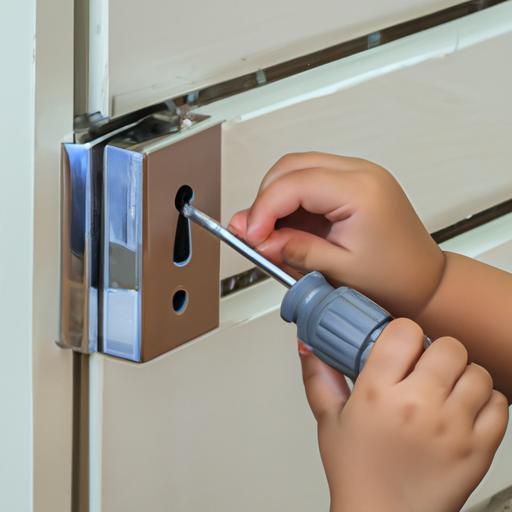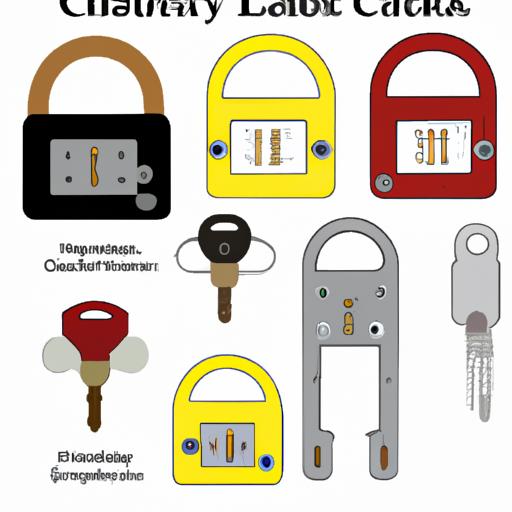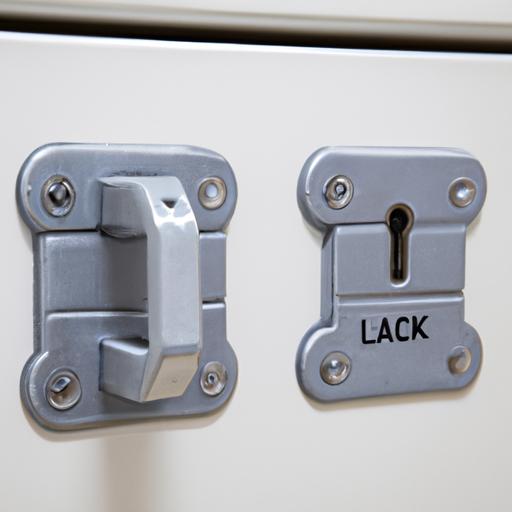How to Open Child Safety Lock on Cabinet: A Comprehensive Guide

Child safety is of utmost importance when it comes to securing our homes. One crucial aspect of childproofing is ensuring that cabinets are equipped with reliable safety locks. However, there may come a time when you need to open these locks, be it for cleaning, rearranging, or simply accessing the contents. In this article, I will guide you through the process of opening a child safety lock on a cabinet, ensuring a hassle-free experience and peace of mind.
Introduction

Child safety locks on cabinets serve as a protective barrier, preventing curious little ones from accessing potentially harmful items. These locks act as a deterrent, safeguarding children from accidents and providing parents with a sense of security. However, there are various types of child safety locks available in the market, each with its own mechanism and unlocking method.
Understanding the different types of child safety locks can give you an advantage when it comes to opening them. By gaining insight into their functionality, you can approach the unlocking process with confidence and ease. Let’s explore the common types of child safety locks you may encounter.
Child safety locks can be categorized into magnetic locks, adhesive strap locks, sliding locks, and knob covers. Magnetic locks use powerful magnets to secure cabinets, requiring a magnetic key to release the mechanism. Adhesive strap locks involve attaching a flexible strap to both the cabinet and its door, preventing it from being opened. Sliding locks utilize a sliding mechanism that blocks the cabinet’s handles or knobs. Lastly, knob covers encase the entire knob, making it difficult for children to grasp and turn.
By familiarizing yourself with these types of child safety locks, you’ll be better equipped to open them effortlessly whenever the need arises. In the subsequent sections, we’ll dive into the step-by-step process and alternative solutions for opening these locks, ensuring your child’s safety while allowing easy access to your cabinet contents. So, are you ready to unlock the secrets of child safety locks on cabinets?
Stay tuned for Section II, where we will delve into the understanding of child safety locks on cabinets and their functionality.
Understanding the Child Safety Lock on Cabinets

Child safety locks on cabinets serve a vital purpose in protecting children from potential hazards. Understanding their functionality and purpose is key to effectively opening them when necessary. Let’s delve into the intricacies of these locks and explore the different types and mechanisms they employ.
Functionality and Purpose of Child Safety Locks on Cabinets
Child safety locks are designed to restrict access to cabinets, preventing children from reaching dangerous substances, sharp objects, or fragile items. They act as a barrier, ensuring the safety of curious little explorers while allowing adults to maintain easy access to the cabinet’s contents.
The primary purpose of these locks is to mitigate the risk of accidents and injuries that may occur when children gain unauthorized access to cabinets. By installing child safety locks, parents and caregivers can create a secure environment, providing peace of mind and reducing the likelihood of accidents.
Different Types of Child Safety Locks and Their Mechanisms
Various types of child safety locks are available in the market, each employing a unique mechanism to secure cabinets. Understanding the different types can help you identify the lock on your cabinet and subsequently determine the appropriate method for opening it.
-
Magnetic Locks: These locks utilize the power of magnets to secure cabinets. A magnetic key is required to release the mechanism, making them an excellent choice for cabinets with no visible hardware.
-
Adhesive Strap Locks: Adhesive strap locks involve attaching a flexible strap to both the cabinet and its door. By preventing the door from being opened, these locks offer a reliable solution for cabinets with handles or knobs.
-
Sliding Locks: Sliding locks feature a sliding mechanism that blocks the handles or knobs of the cabinet, preventing them from being turned or pulled open. They are versatile and can be used on various cabinet types.
-
Knob Covers: Knob covers encase the entire knob, making it challenging for children to grasp and turn. These covers are ideal for round or cylindrical knobs and provide an effective deterrent for curious little hands.
By familiarizing yourself with these different types of child safety locks and their mechanisms, you’ll be better equipped to handle the unlocking process. In the following sections, we will provide step-by-step instructions on opening each type of lock, ensuring the safety of your child and the accessibility of your cabinet contents.
Stay tuned for Section III, where we will discuss the tools required to open a child safety lock on a cabinet.
Tools Required to Open a Child Safety Lock on a Cabinet
Child safety locks on cabinets are designed to keep little ones out, but there may come a time when you need to gain access. To successfully open a child safety lock, you’ll need a few essential tools. Let’s take a look at the list of tools required and their respective purposes in opening the lock.
1. Screwdriver
A screwdriver is a versatile tool that comes in handy for various tasks, including opening child safety locks. Depending on the type of lock you have, you may need either a flathead or a Phillips screwdriver. This tool is used to remove any screws or fasteners securing the lock in place.
2. Magnet
If you have a magnetic child safety lock, a magnet becomes an essential tool. The magnetic key that opens the lock is usually a small, powerful magnet. By using a strong magnet, you can simulate the action of the key and release the lock mechanism.
3. Hairpin or Paperclip
For certain types of locks, such as those with a pinhole or small opening, a hairpin or paperclip can be a handy tool. These items can be bent or manipulated to act as makeshift keys, allowing you to unlock the cabinet.
4. Plastic Card
In some cases, a plastic card, such as a credit card or an old gift card, can be used to open a sliding child safety lock. By sliding the card between the cabinet door and the lock mechanism, you can disengage the lock and gain access.
5. Rubber Band
A rubber band can be used in conjunction with a screwdriver or other tools to provide extra grip and leverage. By wrapping the rubber band around the handle or knob, you can increase your grip and make it easier to turn or manipulate the lock mechanism.
Remember, the specific tools required may vary depending on the type of child safety lock you have. It’s important to identify the lock type and gather the appropriate tools before attempting to open the cabinet. By having these essential tools at your disposal, you’ll be well-prepared to tackle any child safety lock and ensure the safety of your child while accessing the cabinet contents.
Stay tuned for Section IV, where we will provide a step-by-step guide on how to open a child safety lock on a cabinet.
Step-by-Step Guide: How to Open a Child Safety Lock on a Cabinet
Child safety locks on cabinets may seem daunting to open at first, but with the right approach and tools, you can easily unlock them. Follow this step-by-step guide to successfully access the contents of your cabinet while ensuring your child’s safety.
1. Step 1: Identify the type of child safety lock on the cabinet
Before attempting to open the child safety lock, it’s crucial to identify the specific type of lock installed on your cabinet. As mentioned earlier, there are various types such as magnetic locks, adhesive strap locks, sliding locks, and knob covers. This knowledge will help determine the appropriate unlocking method.
2. Step 2: Gather the required tools
Depending on the type of child safety lock, you may require specific tools to unlock it effectively. For magnetic locks, you’ll need a magnetic key. Adhesive strap locks might be opened by pressing or releasing a latch. Sliding locks typically require a small tool, such as a flathead screwdriver or a butter knife. For knob covers, you may need a strong grip or a specialized tool designed to remove them.
3. Step 3: Insert the appropriate tool into the lock mechanism
Once you have identified the type of child safety lock and gathered the necessary tools, it’s time to proceed with unlocking. Follow the manufacturer’s instructions, if available, to insert the tool into the lock mechanism correctly. Ensure a firm grip on the tool to exert the necessary pressure or rotation.
4. Step 4: Apply gentle pressure or rotate the tool to unlock the cabinet
With the tool inserted into the lock mechanism, apply gentle pressure or rotate the tool in the designated direction. Take care not to use excessive force, as it may damage the lock or the cabinet itself. By following the correct method, you should feel the lock release, allowing you to open the cabinet.
5. Step 5: Repeat the process if necessary
In some cases, the child safety lock may require multiple attempts to unlock successfully. If your initial attempt is unsuccessful, repeat the process, ensuring that you are using the correct tool and following the instructions accurately. Patience and persistence are key in safely opening the child safety lock.
By following these step-by-step instructions, you can confidently unlock child safety locks on cabinets without compromising your child’s safety. Remember, always exercise caution and refer to the manufacturer’s guidelines if available. In the next section, we will explore alternative solutions for opening child safety locks on cabinets if the primary method fails. Stay tuned!
Stay tuned for Section V, where we will discuss alternative solutions to opening child safety locks on cabinets.
Alternative Solutions to Opening Child Safety Locks on Cabinets
Child safety locks on cabinets are designed to be secure, but there may be instances where the primary method of unlocking fails or is not feasible. In such cases, it’s essential to have alternative solutions up your sleeve. Let’s explore some different methods and techniques that can come in handy when opening child safety locks on cabinets, as well as the safety precautions to consider.
1. Using Household Items as Tools
If you don’t have the specific tools required for opening the child safety lock, don’t worry! Everyday household items can often serve as effective alternatives. For example, a credit card or a sturdy plastic card can be used to slide between the cabinet door and the frame, pushing the latch or catch mechanism to release the lock. Remember to use caution and apply gentle pressure to avoid damaging the card or the cabinet.
2. Heat or Cold Application
In certain cases, applying heat or cold to the lock mechanism can help loosen it and make it easier to open. For instance, using a hairdryer to apply heat to the lock can expand the metal components, potentially making it easier to manipulate. On the other hand, using an ice pack or a can of compressed air can cause the metal to contract, possibly loosening the lock. However, it’s important to be careful with heat sources and not to expose plastic components to excessive heat.
3. Seeking Professional Assistance
If all else fails or if you are uncomfortable attempting alternative methods, it’s advisable to seek professional assistance. Locksmiths or childproofing experts have the necessary knowledge and tools to open child safety locks without causing damage to the cabinets or compromising safety.
Safety Precautions to Consider
While attempting alternative solutions, it’s crucial to prioritize safety for both yourself and your child. Here are some precautions to keep in mind:
a. Supervision
Always supervise your child closely during the unlocking process to prevent any accidents or injuries.
b. Avoid Using Excessive Force
Refrain from using excessive force or tools that may cause damage to the cabinet or the lock mechanism.
c. Use Caution with Household Items
When using household items as tools, exercise caution to avoid injury or damage. Be mindful of sharp edges or fragile materials that could cause harm.
Remember, alternative solutions should only be considered if the primary unlocking method fails or is not viable. It’s essential to prioritize safety and exercise caution throughout the process. By being prepared with these alternative methods and taking necessary precautions, you can ensure a smooth and secure unlocking experience.
Stay tuned for Section VI, where we will conclude our comprehensive guide on opening child safety locks on cabinets, emphasizing the importance of child safety and summarizing the steps discussed.
Conclusion
In conclusion, knowing how to open a child safety lock on a cabinet is essential for parents and caregivers. Child safety locks play a crucial role in preventing accidents and keeping our little ones safe from potential hazards. By following the step-by-step guide provided in this article, you can confidently unlock cabinets while maintaining the safety measures put in place.
We discussed the importance of child safety locks and the various types available in the market, including magnetic locks, adhesive strap locks, sliding locks, and knob covers. Each type has its unique mechanism and unlocking method. Understanding these different mechanisms empowers you to approach the unlocking process with ease and efficiency.
Remember, safety should always be the priority. When attempting to open a child safety lock, make sure to gather the necessary tools and follow the instructions carefully. If the primary method doesn’t work, don’t worry. We also explored alternative solutions that you can try to successfully open the lock.
At tintucvn365.com, we believe in creating a safe and secure environment for children. By equipping yourself with the knowledge and techniques outlined in this article, you can ensure the well-being of your little ones while maintaining the functionality of your cabinets.
So, the next time you find yourself in need of accessing a locked cabinet, you can confidently tackle the child safety lock. By following the steps and alternative solutions provided, you’ll be able to open the lock and keep your child safe at the same time.
Remember, child safety is a top priority, and tintucvn365.com is here to help you navigate the challenges and ensure a secure environment for your little ones.
Thank you for reading! If you found this article helpful, please share it with other parents and caregivers who might benefit from this information.





